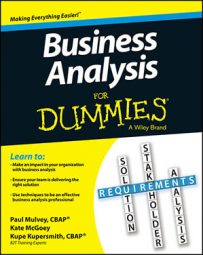When verifying and validating solutions, you perform a requirements review, a structured audit in which you give participants the opportunity to ask questions and make suggestions in order to improve the quality of the product being reviewed. Keeping the requirements review session moving forward is the facilitator’s job; because you may be wearing that hat during the meeting, here are some tips for conducting the requirements review session:
Put on a thick skin when documents you authored are being reviewed.
Listening to people find mistakes and confusing statements within something you created isn’t fun, but you have to get used to it. The purpose of the review is to improve the quality of your end result. Think about how much worse you’d feel months later if that mistake caused a huge defect and delay in the system test!
Make sure reviewers provide constructive criticism.
Participants really shouldn’t criticize the author or the product unless they offer a suggestion. When someone points out an error, ask her to explain how she would’ve fixed it or written it. In this way, you get people to improve the quality, and the resulting suggestions reflect the group’s effort.
Use a parking lot.
If items crop up that are taking you off topic, list them on a parking lot (a temporary holding spot for items that arise in the meeting). Using this tool keeps the meeting momentum flowing without losing track of potentially important points. At the end of the meeting, review the parking lot list and assign those items that weren’t discussed.
To encourage people to participate, send each an individual e-mail ahead of time to identify areas that you’re going to ask for personal input on.
People will be more inclined to review a specific section if they know they’ll be called on.
Don’t get caught up in the grammar of the text or the aesthetics of a prototype.
The primary purpose of the meeting is to come to one common understanding of the requirements. Correct the grammar and aesthetics only if they keep participants from understanding the meaning.

